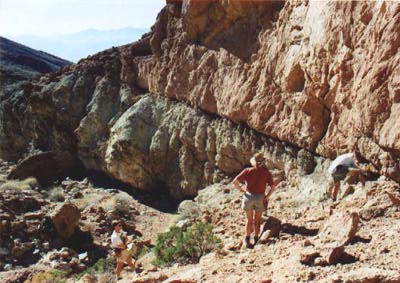
The moving earth
Fig. 1. View of the Copper Canyon detachment fault, exposed in the Black Mountains east of Death Valley. The distinct line of the fault separates rocks of different types which were not originally adjacent. The scientists on this expedition seek to define an analogous fault on the east side of the Atlantis Massif, except that it's underwater and buried.
Photo courtesy of Dr. Darrel Cowan, Professor; Department of Geological Sciences, University of Washington, Seattle. http://www.geology.washington.edu/ ~cowan/faultrocks.html
As scientists aboard the R/V Atlantis try to understand how the underwater mountain beneath them formed, one key type of evidence they seek is the presence, or absence, of what geologists call "faults." Those are the surfaces along which two adjoining blocks of crust slide when they move.
For example, along the Mid-Atlantic spreading center just east of this mountain, portions of the ocean floor may be sliding upward and outward as they pull apart along what's called a "detachment fault" - much like Toronto's all-weather Sky Dome stadium roof does, said Cann. A detachment fault is a special type of normal fault
Link: What's the SkyDome?
The SkyDome homepage.
http://www.skydome.com/
Link: Opening the SkyDome (754 Kb)
External view of SkyDome roof retracting from the Toronto Bluejays' homepage.
Caution: may take several minutes to load on a 56K modem.
http://www.bluejays.ca/local/video/DOMEEXT.MOV
That would be a different process than is thought to occur along most spreading centers. Typically, oppositely moving plates form new ocean floor similarly to the way ice evolves in the arctic. There, cracks are sealed quickly when new ice forms as seawater meets the freezing air, to use the analogy of Tuzo Wilson.
Link: Who is Tuzo Wilson?
J. Tuzo Wilson: Discovering transforms and hotspots. A USGS page.
http://pubs.usgs.gov/publications/text/Wilson.html
At an ocean spreading center, however, it's closer to fire than to ice. Hot magma from Earth's underlying mantle upwells through conduits known as "dikes," sealing the rift in the ocean floor and creating new crust in the process.
Link: What happens at most spreading centers?
A quick explanation from PBS: A Science Odyssey:
http://www.pbs.org/wgbh/aso/tryit/tectonics/divergent.html
Today's pages:
The Moving Earth | Faulting | DSL-120 and ARGO-II | Bringing Out Alvin | Thanksgiving Day

|










